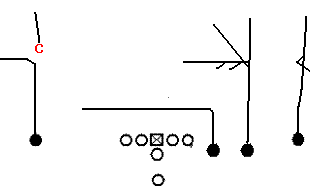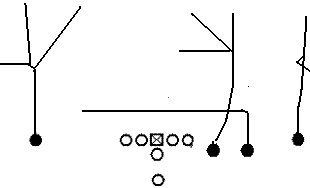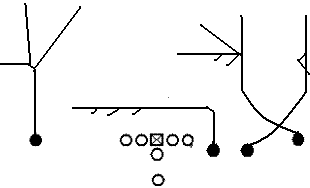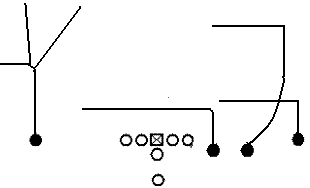 The previous posts have cleared away much of the heavy lifting: we know about the basic principles behind the offense, and we know about that most important of routes, the seam read.
The previous posts have cleared away much of the heavy lifting: we know about the basic principles behind the offense, and we know about that most important of routes, the seam read.But the route that maybe most exemplifies the offense's variable, adapting approach to attack defenses, is probably the Choice route. And it is a concept that is used by many, many teams -- in one form or another -- across the football spectrum.
It is another trips play, and is intended to be used as a counter to the Go when the defense overplays to the three-receiver side. The "choice" in the route belongs to the singled up backside receiver -- often the "X" receiver. The idea is that you put your stud there and make the defense wrong every time, until they overshift to that side, thus opening up the three receiver side for easy plays or big ones. The base form of the route is shown below.

To the three receiver side, it is simple and familiar to what was done with the Go: the outside receiver runs a "streak read" (burst on a vertical route, but if you can't beat the defender, break down at 14-15 yards and come back down towards the line of scrimmage); the middle slot runs the seam read (attack the near safety and then have a multiple way go depending on the coverage -- explained in depth here); and the inside slot runs a five-yard drag route (explode to five yards, then drumroll the feet and head across the field; may settle down in a hole in the zone once on the opposite side of the field).
The single-side "choice" receiver, typically, has three options: run an out at 10-12 yards (or a comeback at 15); run a glance or skinny post (cut on the seventh step at a skinny angle, never crossing the near hashmark); or run a vertical go route. How does he know what to run? And how does the quarterback know what he's running?
The Choice Route Itself
So how do you handle the choice route itself? The R&S guys themselves -- Mouse Davis, Jones, Jenkins, and all the rest -- typically taught this as a true "read" route: it was all done on the fly. The QB and receiver simply had to be on the same page, and they were confident that they could complete this pass whenever they wanted.
To run this route I don't think you have to commit to this; admittedly it takes a great deal of practice time and young quarterbacks and receivers have plenty else to work on. But, in brief, the R&S guys did this about how you'd expect:



Below is a clip from Mike Drake from Longmont High (CO), where they throw the choice route backside against Cover 1 (man-to-man with one deep safety). (They keep some extra protection in on this play so it is a three-man route, but it's the same concept except without the drag.)

But, as observed above, the quarterback and receiver both had to read all this on the fly -- not always easy, and it certainly requires a lot of practice. As a result, what most teams do (and I recommend) is to handle all of these "choices" as a pre-snap adjustment between the quarterback and receiver by hand-signal.
The rules basically work the same as before, though since it is predetermined you can expand the options to include corner routes or anything else. Specifically (thanks to Ted Seay for these):
If the corner plays inside leverage, run a speed out at 10-12 yards;
if the corner presses, run the go/fade route; and
if the corner plays outside leverage, run the skinny post/glance route.
Voila. But how do they communicate this? Well, it ain't rocket surgery, but it can be done either verbally or by hand signal. One way is to use very specific ones, just with the quarterback making his signal behind his back. The other is to do something as follows:
The quarterback, before the snap, will hold his hands in the usual ready position, but with subtle variations:
Outside hand slightly higher than inside hand = Speed out
Inside hand slightly higher = post glance (in breaking route)
Hands slightly higher than normal = go/fade
There's tons of other variations. If you (for some reason) keep the choice between one of two routes, then the "signal" can just be eye contact between the quarterback and receiver pre-snap. Finally, another twist is to let the receiver make the decision, and signal the route by switching his feet in his stance and then back, or by where he places his hands -- the list goes on.
The obvious downside, however, with doing it all pre-snap is that the defense can sometimes fake you out: the corner can play way off and then come up at the snap to play a press technique, or vice versa. But those kinds of fears vary depending what level you're at. If you're in the pros, where they do all that stuff on every play and Ed Reed will play the deep half of the field while lining up in the guard-tackle gap faking a blitz, then you ought to be able to teach people to read on the fly. If you're in high school (or college really too), then the pre-snap stuff should be more than sufficient.
So that's the Choice. It's a great route, especially if you put your best receiver there, as most teams do. Yet, if you're too much of a wuss to do even the pre-snap decisions, you can always "lock" the route and just signal it in from the sideline. That's permissible too, because you still get a one-on-one with great backside capabilities. Let's turn to the backside now.
Backside and variations

As we can see, the backside has lots of options. The two most important are the drag and the seam-read.
First, if the weakside linebacker or flat defender tries to widen out to stop either the speed out or glance, then the drag route should come wide open in that voided territory. See below.

Similarly, in the above diagram, if both the choice route and the drag are taken away, the quarterback will look to the free safety -- he is probably cheating too far to the single receiver side and therefore the backside seam should be open. As an example, see the below clip from Mike Drake again, this time against Cover 3. The defense brings the ever popular "Magic Blitz" or overload zone-blitz with three-deep behind it. They don't block it quite right, but the quarterback moves his feet. (They also put their TE on a kind of "climb" route to help draw the free-safety, which is exactly what he does below.)
To better clarify, here is a diagram of what the receivers were doing and the free-safety's movement where his taking the tight-end opened up the seam reader.

Against a cover two, the calculus changes slightly but the basic progression and read is the same. See below, and then watch the clip again just paying attention (as best you can) to the free-safety.

To stop both the go route by the single receiver and the drag by the slot, the linebackers, corner, and safety have to overreact to the single-receiver side. As a result, the quarterback should be able to work the deep hash safety to the three-receiver side, who has a two-on-one with the seam-read (now running a post) and the backside streak. If the middle linebacker tries to retreat to take away the post (common with the so-called "Tampa Two" defense) the quarterback still has both the drag runner who has settled into an open spot and the running back that he can drop the ball to underneath for a catch and run. (Keep throwing those check-downs until the defense comes up for them; that's when you gash them for the big play.)
Again, another clip from Mike Drake. Here it is against Cover-2: the deep hash safety plays very deep, however, so the seam-reader throttles it down a bit into the void for a nice completion. See below.
So that's the basic framework. Really, you can just teach the quarterback to read: (1) choice, (2) drag, (3) seam-read, (4) backside streak-read, and (5) (outlet) the runningback on a "leak-out" route.
Below are a few variations to the backside. The two most common just switch assignments. In the first, we switch the two-slots so you can get a "rub" for the drag receiver's man.

In the next, the two outside receivers switch assignments. I will discuss the true run and shoot "switch route" in a later part in this series, but this illustrates the basic gist. Again, all you're doing is changing assignments.

The next is a slight variant on the traditional run and shoot formation because it uses the "bunch formation," where the three receivers tighten their splits so that they line up no more than one-yard apart.

This set lets the receivers get more rubs against man coverage -- you can see from the image that now the outside receiver runs the drag and any defender playing man to man on him will have a difficult time covering. This is a great response to teams who think the way to play you on choice is to go to man coverage. And if they stay in zone, well you have all the good zone-stretches I outlined above.
The final variant is the most different, but also the one most increasingly popular: "levels." I have described previously how the Indianapolis Colts use this concept, but June Jones has really used this route ever since he got to Hawaii. (Note they will do all the same switching of receiver assignments I outlined above in it.)

Here you get both a rub and a high/low type stretch on the inside defenders, typically linebackers. Jones has liked this because it is easy for the quarterback to read, he really just must progression sequentially from the single-receiver and scan across the field. It's not a perfect visual, but below is a version of "levels" with from trips #1 running the deep-in and #2 and #3 running the quick ins.
And, although not quite the same, below is an example of the Green Bay Packers running a version of levels to the three receiver side:
Conclusion
And that's the choice concept. It highlights much of what drives the run and shoot: a well-designed route intended to set up a receiver with many options, combined with a great basic combination with equally as many options.
As a final note, the run and shoot is a four wide-receiver offense. That is how it was designed, and how it is run when one commits to it fully. If you don't use four wides -- for example, by substituting in a tight-end -- many of the purists would say you aren't a run and shoot team anymore. I will leave that debate for a later day. I just want to point out that it wouldn't be too difficult to imagine the Choice where the drag runner is actually a tight-end instead of a slot receiver. Indeed, many pro teams would agree with you.
Tidak ada komentar:
Posting Komentar